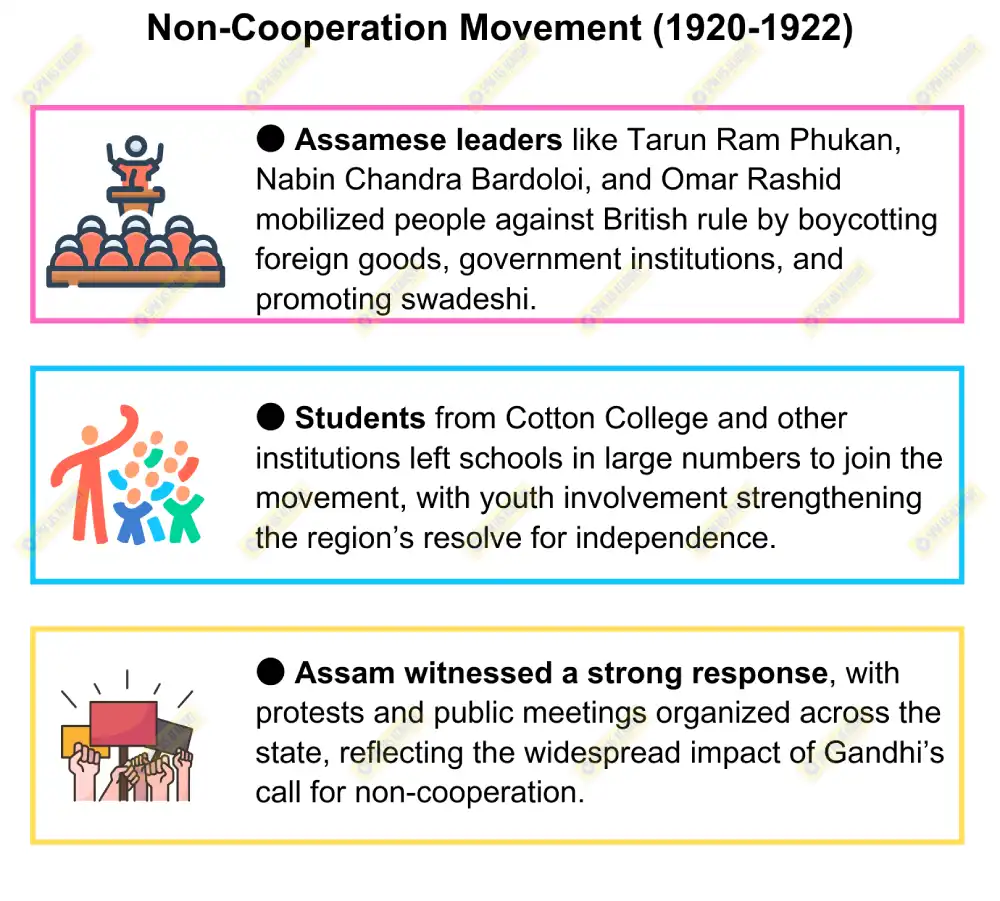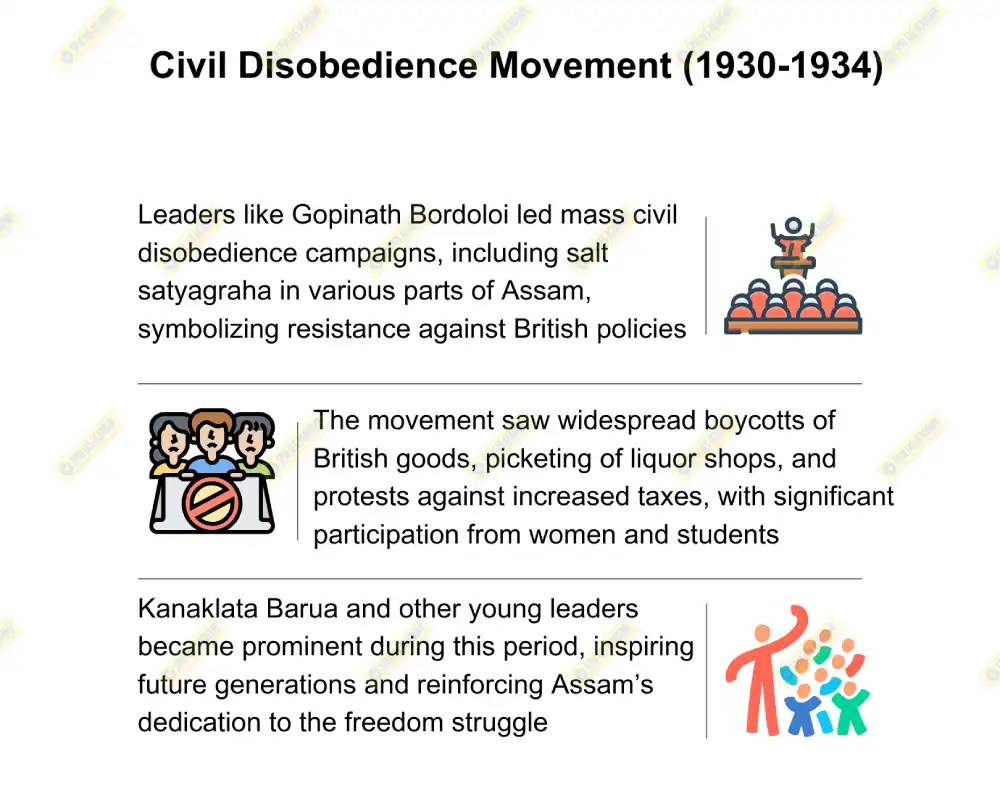The Assamese character in the Indian National Freedom Movement from 1921 to 1942 was marked by resilience, cultural pride, and an enduring commitment to India’s independence. During this period, Assamese leaders and activists played significant roles, participating in key movements such as the Non-Cooperation, Civil Disobedience, and Quit India Movements, while also establishing organizations that promoted local leadership and grassroots mobilization. Their efforts reflected the unique cultural and socio-political identity of Assam, showcasing both dedication to the national cause and the preservation of Assam’s regional distinctiveness.
1. Non-Cooperation Movement (1921–1922)
- Assam was quick to respond to Mahatma Gandhi’s call for the Non-Cooperation Movement in 1921, marking the beginning of widespread political mobilization in the region. Leaders like Tarun Ram Phukan, known as “Deshbhakta”, played a pivotal role in rallying public support against British rule, urging people to boycott foreign goods and educational institutions.
- The movement saw significant participation from students, teachers, and laborers. Assamese students left government schools and colleges in large numbers, embodying a spirit of defiance that became a hallmark of Assam’s role in the national struggle. Tarun Ram Phukan emphasized, “True patriotism is built on sacrifice,” as he led efforts to localize the Swadeshi movement and promote khadi, which became symbols of Assamese pride and resistance.
2. Assam Association and Assam Pradesh Congress Committee (APCC)
- The Assam Association, initially focused on socio-cultural issues, soon adopted a nationalist stance, aligning itself with the Indian National Congress’s anti-colonial agenda. Prominent leaders like Rupkonwar Jyoti Prasad Agarwala, an influential cultural icon and freedom fighter, strengthened Assamese identity through his literature and activism, which helped Assam resonate with the national cause.
- The establishment of the Assam Pradesh Congress Committee (APCC) in 1921 further integrated Assam’s aspirations with the Indian National Congress. Leaders like Gopinath Bordoloi, who would later become Assam’s first Chief Minister, emerged from this organization, promoting Assamese unity and emphasizing a secular, inclusive approach to nationalism.
3. Civil Disobedience Movement (1930–1934)
- Assam’s participation in the Civil Disobedience Movement (1930) further underscored its dedication to India’s independence. Under the leadership of Gopinath Bordoloi, a staunch Gandhian, the Assamese took part in salt satyagrahas and boycotted British institutions. Bordoloi famously remarked, “The strength of a nation is rooted in the unity of its people,” echoing his belief that Assam’s struggles were intertwined with India’s larger freedom struggle.
- During this time, Kanaklata Barua, though young, became a symbol of bravery and defiance. She led processions, bearing the Indian tricolor and inspiring others, especially women, to participate actively in the movement. Her later martyrdom in the Quit India Movement would cement her legacy as an icon of Assamese sacrifice for national freedom.
4. Assam Students’ Conference and Cultural Renaissance
- The Assam Students’ Conference, established in 1916, became an essential platform for youth engagement in the freedom struggle. It promoted Assamese language, culture, and social issues while mobilizing students for the national cause. The role of Bishnu Prasad Rabha, known as “Kalaguru” (master of the arts), was particularly notable. His writings, songs, and performances integrated patriotic themes, making the freedom movement accessible and emotionally resonant for the Assamese people.
- The rise of cultural nationalism was also evident through the works of Jyoti Prasad Agarwala, who used art, theatre, and literature to instill a sense of Assamese pride and anti-colonial sentiment. His famous song, “O mor aponar dex” (O my beloved land), became an anthem of Assamese patriotism and solidarity, blending regional pride with national identity.
5. Quit India Movement (1942) and Revolutionary Actions
- The Quit India Movement of 1942 saw Assam once again at the forefront of resistance, as leaders like Gopinath Bordoloi and Tayabullah, president of the APCC, intensified anti-British activities in the region. The youth played a particularly crucial role, with organizations like the All Assam Students’ Federation (AASF) mobilizing young people to join the struggle.
- It was during this time that Kanaklata Barua emerged as a symbol of Assam’s courage and sacrifice. At only 17, she led a procession carrying the national flag and was shot by British forces, becoming a martyr and an enduring symbol of Assamese resistance. Her bravery inspired generations of Assamese people and reinforced the spirit of Assamese women’s active involvement in the freedom movement.
Thus, through organizations like the Assam Pradesh Congress Committee and Assam Students’ Conference, Assamese society participated in mass movements, blending regional identity with the national cause. As Gopinath Bordoloi aptly put it, “Freedom is our birthright, and we will fight till the end to secure it.” The Assamese role in the national freedom movement was marked by a deep-rooted commitment to independence and a lasting impact on Assam’s collective consciousness, setting a legacy of unity and patriotism that resonates to this day.













